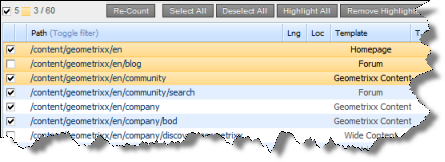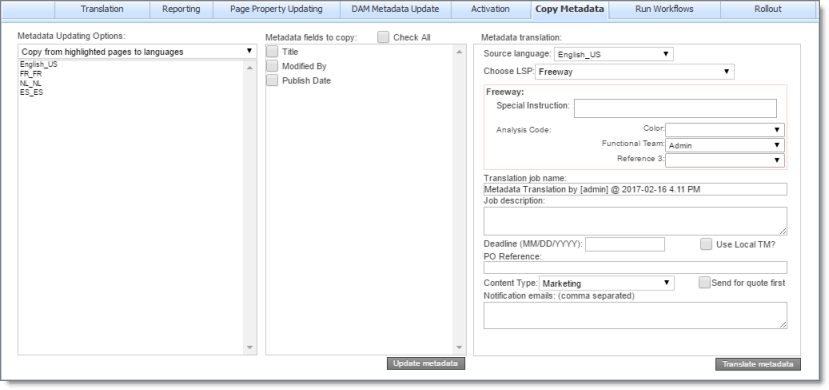You use the Copy Metadata tab of the Globalization Tool to copy metadata to multiple pages that you highlight in the page list in the Globalization Tool, including multiple language copies of those pages. This includes copying metadata from source Blueprint pages to the corresponding livecopy language copies of those pages.
As an optional next step, you can then send out for translation, as a single job, the metadata that was copied over. For details, see Sending Metadata in Multiple Pages for Translation.
Note: In the Page Metadata Configuration section of the Advanced Settings page, you configure which metadata fields are available for selection in the Copy Metadata tab. For detailed configuration instructions, refer to the Lionbridge Connector for Adobe Experience Manager Installation and Configuration Guide.
To copy metadata to multiple pages:
- In the Globalization Tool, display and highlight the pages to which you want to copy metadata. For detailed instructions, see Performing Actions on Multiple Pages and Digital Assets.
- To highlight a page, click in the corresponding row.
Note: Do not click the actual path in the Path column, because that is a link to the page.
- To highlight multiple adjacent pages, press and hold the Shift key.
- To highlight multiple non-adjacent pages, press and hold the Ctrl key.
- To highlight all the pages in the list, click Highlight All.
- To remove the highlight of all the pages in the list, click Remove Highlighted.
- To update the numbers of selected pages, highlighted pages, and total pages at the top-left corner of the list, click Re-Count.
- The number after the check box displays the number of selected pages.
- The number after the highlight displays the number of highlighted pages.
- The number after the slash ( / ) displays the total number of pages.
For example:

Important: Ensure that you highlight the pages in the list, instead of selecting the check boxes.
- In the bottom of the Globalization Tool, click the Copy Metadata tab.

- In the Metadata Updating Options dropdown list, select one of the following:
- Copy from highlighted pages to languages: The Connector will copy the specified metadata from the highlighted pages to the corresponding language copies of those pages. You specify the languages in the section below the list. All source and target languages defined for your team profile are displayed in this list.
- Copy from Blueprint for languages: The Connector copies to the livecopy pages specified in the Language list from the corresponding livecopy source pages.
- In the section below the Metadata Updating Options dropdown list, select the language copies of the highlighted pages to which the Connector will copy the specified metadata.
- To select multiple adjacent languages, press and hold the Shift key.
- To select multiple non-adjacent languages, press and hold the Ctrl key.
- In the Metadata fields to copy section, you select which metadata fields to copy.
Select the check boxes for the metadata fields to copy, or select the Check All check box to select the check boxes for all available metadata fields.
Note: By default, no fields are configured. You must configure these fields in the Page Metadata Configuration section of the Advanced Settings page. For detailed instructions, refer to the Lionbridge Connector for Adobe Experience Manager Installation and Configuration Guide.
- Click Update metadata.
The Submit a new task dialog box opens.

Copying metadata will be displayed as a task on the Backend Tasks page.
- Define the parameters for this task:
| Field | Description |
|---|---|
| Priority | The priority level for this task. This is one of the following: * Normal: The Connector executes this task with normal priority. * Urgent: The Connector executes this task before executing tasks with Normal priority. * Wait for approval: This task must be approved before the Connector executes it. |
| Task Name | The name of the task, as it will be displayed on the Backend Tasks page. |
| Notification | To receive an email notification when the task is executed, select the Need email notification check box. |
| Email addresses | If you selected the Need email notification check box, described above, enter the email addresses that will receive a notification when the task is executed. |
- Click Submit.
A message box states that the task has been saved.
- Click OK to close the message box.
You can view your task on the Backend Tasks page, which you open by clicking Tasks in the Lionbridge Connector rail. If the task requires approval before the report is generated, you can approve it there. For detailed instructions, see Managing Tasks and Accessing Reports.
Important: If you want to send out for translation the metadata that was copied over, first ensure that the Copy metadata task you submitted, described above, has completed. Next, follow the instructions in Sending Metadata in Multiple Pages for Translation.
